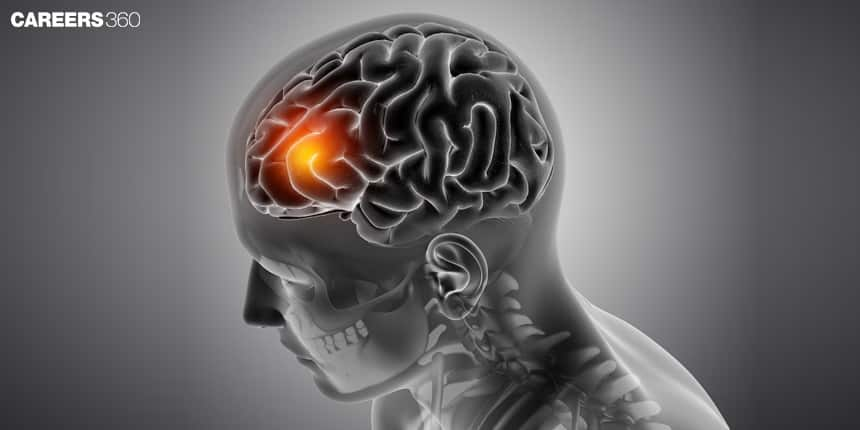Pineal Gland: Definition, What It Is, Function, Disorders, Anatomy, Hormones
The pineal gland is a small, pea-shaped endocrine gland located in the brain between the two hemispheres in a groove where the two halves of the thalamus join. It plays a crucial role in regulating biological rhythms, such as the sleep-wake cycle, by secreting the hormone melatonin. Often referred to as the "third eye," the pineal gland is sensitive to light and darkness, influencing its hormone production. In this article, the Pineal gland, the anatomy of the pineal gland, functions of the pineal gland, and disorders related to the pineal gland are discussed. Pineal Gland is a topic of the chapter Chemical Coordination and Integration chapter of Biology.
This Story also Contains
- What is the Pineal Gland?
- Anatomy of the Pineal Gland
- Functions of the Pineal Gland
- Disorders Related to the Pineal Gland

What is the Pineal Gland?
It is a small, pea-shaped endocrine gland deep within the brain that plays a leading role in generating circadian rhythms and modulating the sleep-wake cycle by synthesizing the hormone melatonin. Discovered and named by ancient anatomists because of its shape, resembling a pinecone, it has inspired many scientists and philosophers; for a period, René Descartes even viewed it as the "seat of the soul". Modern research underlines its role in daily physiological cycles, effects on sleep, and possibly seasonal biological rhythms.
Anatomy of the Pineal Gland
Anatomically, the pineal gland is a small organ.
Location in the Brain
The pineal gland is situated near the middle of the brain and between the two hemispheres in a depression where the two parts of the thalamus are joined. It is part of the epithalamus, just above the midbrain and near the third ventricle.
Structure and Size
It is only about 5 to 8 millimetres in length. As the name implies, it is pinecone-shaped. It is composed of cells called pinealocytes that produce the melatonin, and secondarily, some supporting glial cells. The gland is highly vascularized, second only to the kidneys, an indication of the importance of its hormone-production role in the body.
.jpg)
Also Read:
Functions of the Pineal Gland
It controls the circadian rhythms, the natural internal processes that occur in living organisms in an approximately 24-hour cycle and which respond primarily to light and darkness in the environment.
Regulation of Circadian Rhythms
The regulation of circadian rhythms occurs by
Melatonin Production
The pineal gland produces melatonin, a hormone indirectly released into the circulation in response to darkness. Melatonin signals the body that it is night and time to sleep. By doing this, the pineal gland helps create the proper sleep-wake cycle.
Sleep-Wake Cycle
Melatonin, through its release by the pineal gland, influences the sleep-wake cycle directly through the induction of drowsiness during the evening and regulating the time of sleep and wakefulness.
Seasonal Biological Rhythms
It also participates in seasonal biological rhythms, like those linked to reproduction and mood and it modulates the production of melatonin as a function of the length of days from one season to another.
Regulation of Hormones
One way melatonin controls other hormonal functions is by its indirect action on their synthesis and release into the circulatory system. Melatonin, as such, controls other varied hormonal functions, such as those associated with reproductive health and stress response. Interaction with other Endocrine Glands
The pineal gland coordinates its activity with that of other endocrine glands, including the hypothalamus and pituitary gland. This helps in integrating or synchronizing the hormonal signals throughout the body so that different physiological processes are appropriately coordinated.
Disorders Related to the Pineal Gland
There are disorders related to the Pineal gland.
Pineal Gland Dysfunction
The pineal gland dysfunction results in circadian rhythm disturbance and sleeping disorders. Sleep disorders, due to the imbalance of melatonin production, could include insomnia or somnambulism.
Pineal Tumors
Although rare, pineal tumours still do occur and are said to be either benign or malignant. The symptoms produced by these tumours result from compression of the surrounding structures in the brain, characterized by headaches and impaired vision; hydrocephalus eventually develops in severe cases. Treatment often comprises surgery, radiation therapy, or chemotherapy.
Calcification of the Pineal Gland
Calcification of the pineal gland is quite a common condition, and it accelerates with advancing years. While it may be considered part of the process of ageing, extreme excess calcification will inhibit melatonin production, leading to sleep disorders and a myriad of neurodegenerative diseases. The reason behind pineal gland calcification is yet not very well understood, although it is believed to be due to exposure to certain environmental factors and metabolic processes.
Also Read:
| Mechanism of Hormone Action | Hormone Receptors |
| Adrenal Cortex | Adrenal Medulla |
| Difference between Thyroid and Parathyroid | Adrenal Insufficiency |
Recommended Video for Pineal Gland
Frequently Asked Questions (FAQs)
This will be about the impact of light, more so than blue light from screens, on the production of melatonin by the pineal gland and its relation to sleep.
Symptoms may include sleep disorders, depression, fatigue, and hormonal imbalances.
A little calcification over the years due to ageing, but the low fluoride intake and clean living avoid excess calcification.
The pineal gland synthesizes the hormone melatonin, relating it to sleep/wake cycles.
It lies near the centre of the brain, between the two hemispheres, in the groove where the two halves of the thalamus join.